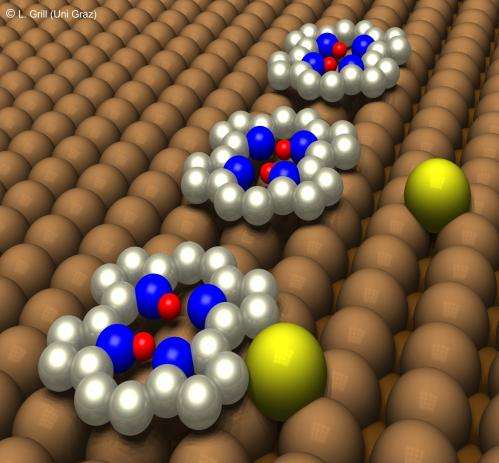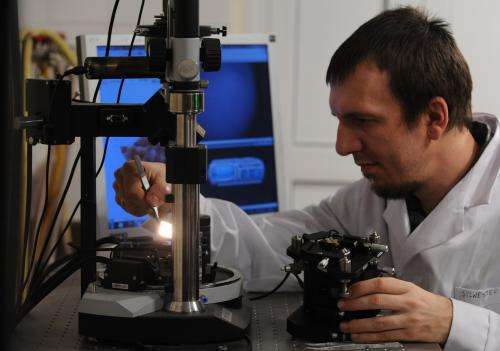Two-proton bit controlled by a single copper atom

Just a single foreign atom located in the vicinity of a molecule can change spatial arrangement of its atoms. In a spectacular experiment, an international team of researchers was able to change positions of the nuclei of hydrogen atoms in a porphycene molecule by placing it in proximity to a single copper atom.
A subatomic bit formed by two protons tunnelling inside a simple organic molecule can be switched by approaching a single copper atom to the molecule. A spectacular experiment to demonstrate the phenomenon was carried out by a team of researchers from the Fritz-Haber-Institute of the Max-Planck-Gesellschaft (FHI) in Berlin, the University of Liverpool (UL) and the Institute of Physical Chemistry of the Polish Academy of Sciences (IPC PAS) in Warsaw. The experiment was reported in a paper published in Nature Chemistry, one of the most prestigious chemical journals.
In the study the researchers made use of specific properties of the porphycene molecule. Porphycene (C20H14N4) is a porphyrin derivative. Chemical compounds belonging to this group occur naturally. They are found, e.g., in human blood, where they are involved in reactions related to oxygen transport. Their molecules have a form of planar carbon rings with hydrogen atoms outside and four nitrogen atoms inside, located in the corners of a tetragon.
In the centre of a porphycene molecule, in an empty space surrounded by nitrogen atoms, there are two protons (i.e., nuclei of hydrogen atoms) that can move between the nitrogens. It is interesting that both protons are always displaced together. The research carried out for over a decade by Prof. Jacek Waluk's team (IPC PAS) suggests that the movement of protons is not simply a displacement in space. The protons change their positions due to quantum tunnelling effect: making use of the uncertainty principle they just disappear at one place and reappear in another.
In the Berlin FHI laboratory the porphycene molecules provided by Prof. Waluk's team were deposited individually onto the surface of a perfect copper crystal. The job was not easy and required development of appropriate techniques – without them, porphycene molecules tended to form groups (aggregates).
The subsequent step involved experiments under high vacuum and at very low temperature (5 K, which means five degree above the absolute zero). A single porphycene molecule laying on the copper substrate was observed with a scanning tunnelling microscope. The instrument allowed for recording changes in electron density of the molecule, and thus for monitoring changes of its shape. The images obtained with this technique revealed current positions of both protons. Therefore the researchers were able to observe the movement of atoms inside the molecule in the course of a chemical reaction.
"We were pretty much surprised to find that after depositing on the copper substrate, hydrogen ions in porphycene molecule formed a configuration that was never observed so far, in spite of many, many years of research on this compound. Instead of being located in opposite corners of the tetragon formed by nitrogen atoms, both protons took positions next to each other. Quite surprisingly we found a new porphycene tautomer," says Prof. Waluk.

Using a tip of the scanning tunnelling microscope, a single copper atom was moved closer to the porphycene molecule, from different sides. It turned out that depending on the position of the copper atom, both protons in porphycene, moving between the nitrogen atoms, were located once on one side, and then on the other side of the molecule. Thus, the porphycene molecule acted as a binary switch, controlled with only a single copper atom. A change in position of the copper atom by less than ten-billionth of a meter was sufficient to initiate the transition between the states.
The research carried out by the team from the FHI, the UL and the IPC PAS proves that the vicinity of a molecule can substantially affect its physical and chemical properties. The results of the study show that, under certain conditions, the environment of molecules should be controlled with atomic precision. On the other hand, the observed sensitivity to changes in the environment opens the way for development of methods for regulation of processes occurring in single molecules.
"It seems likely that the molecule's sensitivity to its vicinity found by us is a common phenomenon in nature. The phenomenon can be exploited, for instance, in designing nanomachines processing information on a single-molecule level", sums up Prof. Waluk.
More information: "Controlling intramolecular hydrogen transfer in a porphycene molecule with single atoms or molecules located nearby." Takashi Kumagai, Felix Hanke, Sylwester Gawinkowski, John Sharp, Konstantinos Kotsis, Jacek Waluk, Mats Persson & Leonhard Grill. Nature Chemistry 6, 41-46 DOI: 10.1038/nchem.1804: 1 December 2013
Journal information: Nature Chemistry
Provided by Polish Academy of Sciences




















